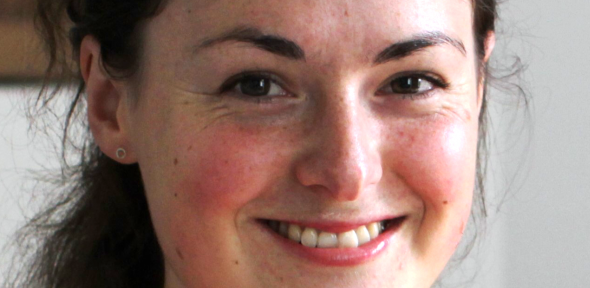
Rachel Rose Smith is the curator for Downing College’s new Heong Gallery - part of this year's Bridge the Gasp route - which opened in February. Her previous experience includes co-curating the 2014 Tate St Ives exhibition, International Exchanges 1915–65: Modern Art and St Ives, with Sara Matson and Chris Stephens. Rachel has recently submitted her doctoral thesis titled ‘Modern Art Movements and St Ives, 1939–49’, which focuses on the development of Cubist and Constructivist lineages of art in West Cornwall during and immediately after the Second World War.
The Open Cambridge team asked Rachel about life at Downing College, the current exhibition at the Heong Gallery, what she has planned for the coming year at the Gallery, and what the Bridge the Gap walkers should look out for when they pass through the grounds.
OC: What does the role of Gallery Curator entail?
RRS: I’ve been working with Downing to develop the Heong Gallery’s exhibition and events programme. Working on the first exhibition, Generation Painting 1955–65, for example, involved making decisions about which paintings to display and how to present them in a way that is accessible and visually appealing, and producing the catalogue with authors and designers. More administrative tasks ranged from organising the insurance and transport of these paintings to asking for permission to reproduce them on postcards.
OC: Can you tell us a little about the background to the Heong Gallery?
RRS: The Gallery building was first built as stables, but despite its handy location near the Porters’ Lodge, it had since then mainly been used as a maintenance shed. Some older Members of the College have told me they used to lift weights in it! London-based Caruso St John Architects were appointed to design a Gallery within a new area called ‘First Court’. Their solution made use of a number of features of the original stables block, including the fireplace in the Gallery reception room. The space is best suited to displaying modern and contemporary art, and it was decided that exhibitions would be free for everyone to enjoy.
OC: What will the Gallery be exhibiting around the time of the Open Cambridge Walk, and will walkers be able to see any of this exhibition during or after the Open Cambridge Walk?
RRS: Our second exhibition Ai Weiwei: Cubes and Trees (17 June–9 October 2016) includes both indoor and outdoor sculpture, film, wallpaper and smaller objects. As the title suggests, the focus is on two series of works: cubes and trees! Cubes of different materials, including a ton of tea, will be displayed in our main Gallery and the life-size trees will form an uplifting arc in our main College quadrangle. I imagine it will be hard for walkers to miss the trees and all will be welcome in the Gallery for either a quick (or more lingering) look at the other things (we’ll be open till 6pm). One of the films on show is 150 hours long; it’s footage taken by Ai as he journeyed through Beijing with some students. I’m not sure even I will be able to watch all of it, but it’ll offer a continually changing view of the city and the inhabitants who move around it.
OC: What are the Gallery’s plans for the coming year?
RRS: Our Ai Weiwei exhibition will be on until October and there’ll be events at the Gallery all summer, including exhibition tours, talks, a film screening and family workshops. From November, we’ll be showing a selection of works from the collection normally housed by Kettle’s Yard. The exhibition will be formed of artists’ varying depictions of places where they’ve lived or which they’ve come to know. It will be very interesting to see what can be drawn from bringing this group of works together in a Gallery that incorporates views of the surrounding landscape.
OC: What is life like at Downing?
RRS: Downing feels an exciting place to be at the moment, especially for artistic types because of the new Gallery, organ and Howard Theatre. Students seem to be thriving from these new facilities and enjoying initiating their own creative projects. I’m less involved with College pursuits in other fields, but staff and students always seem to be focussed on something within a relaxed and liberal setting.
OC: Where is your favourite place in College and why?
RRS: I think I have two favourite places. Spending time in the Gallery always uplifts me, whether I am there doing something by myself or meeting visitors who have come to take a look. I love watching how it changes throughout the day because of the natural light but I think first thing in the morning is the best. I’m also a fan of the Butterfield Café just the other side of the Library. It has a nice laid-back feel, is always also open to everyone and makes a very handy spot for a morning (and afternoon) coffee.
OC: What do you think makes Downing College so special?
RRS: I always think that Downing offers a spacious way of life, because of the scale of the buildings around the main quad. Perhaps that is what makes for a nice atmosphere of busyness, without ever seeming hectic.
OC: Is there a little-known fact you can reveal about the College that most people wouldn’t know?
RRS: I’m not sure whether it’s rumour or fact but apparently John Cleese perfected his Ministry of Silly Walks movements while he was at Downing, because he was trying to avoid puddles in the gravel paths around the quad.
OC: Other than the Gallery and the art placed outside, what else should people look out for as they walk through the College grounds?
RRS: I would probably recommend that walkers take in the feel of the classical space, taking a broad view of the rhythm of porticos dotted around the main quad. There are also some really lovely trees, but unfortunately I’m not enough of a horticulturalist to go into more detail.

